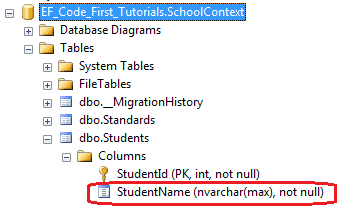Data Annotations - Required Attribute in EF 6 & EF Core
The Required attribute can be applied to one or more properties in an entity class. EF will create a NOT NULL column in a database table for a property on which the Required attribute is applied.
using System.ComponentModel.DataAnnotations; public class Student { public int StudentID { get; set; } [Required] public string StudentName { get; set; } }
In the above code, the Required attribute is applied to the StudentName property. So, EF API will create a NOT NULL StudentName column in the Students table, as shown below.

Now, if you try to save the Student entity without assigning a value to the StudentName property then EF 6 will throw the System.Data.Entity.Validation.DbEntityValidationException exception, while EF Core will throw the
Microsoft.EntityFrameworkCore.DbUpdateException exception.
Note: The Required attribute can also be used with ASP.Net MVC as a validation attribute. Visit Implement Validations in ASP.NET MVC for more information.